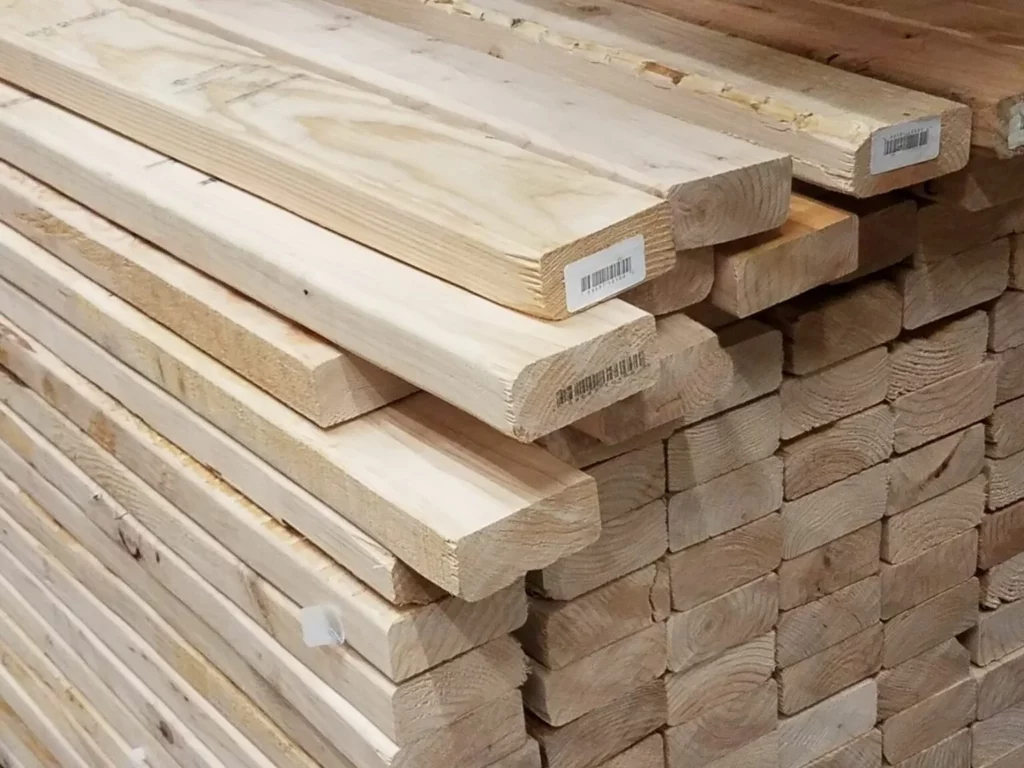Table of Contents

How Much Does the Average 2×4 Weigh?
2×4 weight is the product of a few different factors (see the next section). There is no single correct answer to the question. But just for fun, we’ll try to come up with the answer that has the highest chance of being correct for any randomly selected 2×4 in the world.
More two-by-fours are used as studs for wall framing than anything else, and the most common stud length is roughly 8 feet (92 5/8 inch studs for an 8-foot wall). So our notional 2×4 will be 8 feet long.
Douglas Fir is one of the most commonly used wood species for framing lumber in North America, (particularly in the western United States). It has an average air-dried density of about 30 to 34 lb/ft³.
A standard 2×4 (actual dimensions 1.5 inches × 3.5 inches) contains about 0.0365 cubic feet of wood per foot of length. So at 30 to 34 lb/ft³, a Douglas Fir 2×4 weighs about 1.09 to 1.24 pounds per linear foot. Averaging that range gives 1.165 pounds per foot.
So how much does a 2×4 weigh? Anywhere from 0.84 pounds to 2.65 pounds per linear foot, but the single most common 2×4 weight is probably 9.32 pounds (for one that’s 8 feet long). So let’s make it simple and say the most common weight for a 2×4 is about 9 pounds.
For the weights of lumber with different dimensions, see my Dimensional Lumber Weight article.
2×4 Lumber Weight Calculator
This calculator uses the data I used for the lumber weight table at the bottom of the page.
Note on SPF lumber:
Spruce-pine-fir (SPF) lumber is typically considered one product and it’s often used for dimensional lumber. The properties of spruce, pine, and fir lumber are close enough for them to be considered interchangeable for construction purposes. This means that when you buy lumber for framing or similar structural purposes you are likely to get a mixture of wood species from these three tree genera.
The weight of SPF lumber is therefore an average weight that can change depending on the actual mix of wood species in the particular batch you get. Very generally, the average weight of SPF lumber is usually close to the weight of White Spruce or White Fir. See the table below.
You can read more about the species used for SPF lumber in this article on the American International Forest Products website.
2×4 Weight Factors
Lumber weight depends chiefly on the length of the board, the moisture content of the wood, and which tree species the lumber was made from. Pressure-treating the wood with preservative will also result in a small amount of additional weight after the board has had time to dry out after the treatment process.
Board Length: The length of the 2×4 will obviously be the biggest factor in determining its weight. This is self-explanatory.
Moisture Content: The moisture content of the wood is a big factor as well, but since all lumber tends to eventually arrive at the air-dried moisture content, variations in moisture content can be considered a temporary consideration.
Green lumber has a higher moisture content than air-dried lumber, and air-dried lumber has a higher moisture content than kiln-dried lumber.
Green lumber has a moisture content above 19%. Depending on the actual moisture content of a particular piece of lumber, which can be well above 100% due to the way the moisture content of wood is calculated, green lumber can weigh more than 50% more than the same lumber when air-dried.
The typical weight of green lumber is roughly 10% to 50% more than the dried weight of lumber made from the same wood species.
Kiln-dried lumber normally starts off with a somewhat lower moisture content (6% – 12%) than air-dried wood, but tends to slowly absorb enough moisture from its environment to eventually reach the same moisture content as air-dried wood in the same environment.
Air-dried lumber typically stabilizes at 12%–19% moisture content.
Wood Species: The wood species the lumber comes from is the third important variable in determining a board’s weight. A 10-foot-long air-dried 2×4 made out of Douglas Fir will weigh about 12 and a half pounds. A 10-foot-long air-dried 2×4 made out of Sitka Spruce only weighs around 10 pounds.
Pressure-Treatment: Pressure-treated lumber is notoriously heavy when people first buy it. This is because when you find it in the store or the lumber yard, it’s usually freshly-treated, or it has only been drying for a couple of weeks.
The water weight added to the wood during the pressure-treating process leads to freshly-treated boards weighing up to 75% more than the weight of untreated boards. This weight is temporary. The board will return (almost) to its original weight as it air-dries during the weeks or months after treatment.
A treated 2×4 will weigh approximately 0.4% to 1.5% more than an untreated 2×4 from the same tree species after drying.
Actual Dimensions of a 2×4
Despite what it’s called, a 2×4 does not measure 2 inches by 4 inches. These are its nominal dimensions; the term is based on the board’s size before it has been dried and finished. The actual dimensions of a standard 2×4 are 1.5 inches by 3.5 inches.
Here’s why that is:
Rough-Sawn Dimensions:
When a board is first cut at the sawmill, it’s called rough green lumber, and it’s typically close to the full nominal size, approximately 2″ × 4″.
Drying Shrinkage:
The green lumber is then dried (either air-dried or kiln-dried) to reduce its moisture content. As the wood dries, it naturally shrinks in width and thickness, although not noticeably in length. This shrinkage improves dimensional stability, helping to prevent future warping or cracking after the lumber is used.
Surfacing and Finishing (Planing and Sanding):
After drying, the board is surfaced on all four sides (S4S) to smooth the surfaces and slightly round the edges. This step reduces the size even further to meet standard industry dimensions.
For a standard 2×4, the final actual size is 1.5″ × 3.5″, a result of both shrinkage and planing. These dimensions are standardized by the U.S. Department of Commerce under PS 20, the voluntary product standard for softwood lumber.
For more about nominal vs actual lumber dimensions, see Nominal vs Actual Lumber Dimensions.
How to Calculate 2×4 Weight
Step 1: Determine the wood type. To determine its weight, you need to know what kind of wood the 2×4 is made from.
Step 2: Look up the density of the wood. Once you know what type of wood you’re dealing with, look up the density of the wood in pounds per cubic foot. Weights of Various Woods Grown in the United States has an extensive table of wood species you can refer to, or there are plenty of other resources on the internet with the same information.
Step 3: Calculate the volume in cubic inches of a one-foot-long 2×4. This value will be used to figure out what percentage of a cubic foot a 2×4 is. Since a 2×4 is 1.5 inches by 3.5 inches, a one-foot-long 2×4 will have a volume in cubic inches of 1.5 x 3.5 x 12, or 63 cubic inches.
Step 4: Find what percentage of a cubic foot the volume of a one-foot-long 2×4 is. A cubic foot is equal to 12 inches x 12 inches x 12 inches, or 1,728 cubic inches. A 2×4 is 63 cubic inches per foot. 63 is 1/27.4286 of 1,728, or 3.6458% of a cubic foot (63/1728 x 100 = 3.6458).
Step 5. Find 3.6458% of the density in pounds per cubic foot of your 2×4 wood species. Let’s say you’re trying to figure out the weight of a 2×4 made out of white fir. You look up the density of white fir and see that it’s 26 pounds per cubic foot. Multiply 26 pounds by 0.036458 to get 0.947908 pounds. This is the weight per foot of a 2×4 made from white fir.
Step 6: Multiply by the length of the 2×4. If your 2×4 is 8 feet long, multiply 8 by 0.947908 to get 7.583264 pounds. We’d round this to 7.6 pounds to be practical.
And there you go, an 8-foot white fir 2×4 weighs 7.6 pounds.
About This 2×4 Weight Chart
The following table provides the approximate weight (dead load, self-weight) of 2×4s produced from the various wood species and in the various lengths normally used in building construction in the US.
The values given in the table are meant to provide a general idea of typical 2×4 weights, and should not be used if precise values are needed for critical engineering calculations. The weights are for air-dried lumber; kiln-dried lumber will weigh a little less, and green lumber can weigh a lot more.
When precision is necessary, always refer to the specification sheet for the actual, specific product you intend to use, or contact the technical department of the lumber producer or lumberyard.
You can look up 2×4’s for sale on the Home Depot or Lowe’s websites. The approximate weights of the actual pieces of lumber for sale are often given in the product descriptions, so this can be a pretty good resource for calculating lumber weight.
Table: 2×4 Lumber Weights
| 2×4 Weight by Wood Type and Length | ||||||||
|---|---|---|---|---|---|---|---|---|
| (Average Dry Weight, 12% Moisture Content) | ||||||||
| Type of Wood | Length of 2×4 in Feet (2×4 x number of feet) | |||||||
| These are the most common wood types used in construction in North America. | Weight Per Foot (2x4x1) in Pounds |
2x4x6 | 2x4x8 | 2x4x10 | 2x4x12 | 2x4x14 | 2x4x16 | |
| Pressure Treated Wood | Pressure-Treated (Freshly Treated) | 2.65 lb | 15.9 lb | 21.2 lb | 26.5 lb | 31.8 lb | 37.1 lb | 42.4 lb |
| Pressure-Treated (After Air Drying) | 1.50 lb | 9 lb | 12 lb | 15 lb | 18 lb | 21 lb | 24 lb | |
| Cedar | Western Red Cedar | 0.84 lb | 5.04 lb | 6.72 lb | 8.40 lb | 10.08 lb | 11.76 lb | 13.44 lb |
| Douglas Fir | Douglas Fir (Coast Type) | 1.24 lb | 7.44 lb | 9.92 lb | 12.40 lb | 14.88 lb | 17.36 lb | 19.84 lb |
| Douglas Fir (Mountain Type) | 1.09 lb | 6.54 lb | 8.72 lb | 10.90 lb | 13.08 lb | 15.26 lb | 17.44 lb | |
| Fir | Noble Fir | 0.95 lb | 5.70 lb | 7.60 lb | 9.50 lb | 11.40 lb | 13.30 lb | 15.20 lb |
| Subalpine Fir | 1.20 lb | 7.22 lb | 9.63 lb | 12.03 lb | 14.44 lb | 16.84 lb | 19.25 lb | |
| White Fir | 0.95 lb | 5.70 lb | 7.60 lb | 9.50 lb | 11.40 lb | 13.30 lb | 15.20 lb | |
| Hemlock | Mountain Hemlock | 1.20 lb | 7.20 lb | 9.60 lb | 12 lb | 14.40 lb | 16.80 lb | 19.20 lb |
| Western Hemlock | 1.06 lb | 6.36 lb | 8.48 lb | 10.60 lb | 12.72 lb | 14.84 lb | 16.96 lb | |
| Larch | Western Larch | 1.31 lb | 7.86 lb | 10.48 lb | 13.10 lb | 15.72 lb | 18.34 lb | 20.96 lb |
| Pine | Lodgepole Pine | 1.06 lb | 6.36 lb | 8.48 lb | 10.60 lb | 12.72 lb | 14.84 lb | 16.96 lb |
| Ponderosa Pine | 1.02 lb | 6.12 lb | 8.16 lb | 10.20 lb | 12.24 lb | 14.28 lb | 16.32 lb | |
| Southern Yellow Pine (Loblolly) | 1.39 lb | 8.34 lb | 11.12 lb | 13.90 lb | 16.68 lb | 19.46 lb | 22.24 lb | |
| Southern Yellow Pine (Longleaf) | 1.49 lb | 8.94 lb | 11.92 lb | 14.90 lb | 17.88 lb | 20.86 lb | 23.84 lb | |
| Southern Yellow Pine (Shortleaf) | 1.39 lb | 8.34 lb | 11.12 lb | 13.90 lb | 16.68 lb | 19.46 lb | 22.24 lb | |
| Southern Yellow Pine (Slash) | 1.57 lb | 9.42 lb | 12.56 lb | 15.70 lb | 18.84 lb | 21.98 lb | 25.12 lb | |
| Spruce | Engelmann Spruce | 0.84 lb | 5.04 lb | 6.72 lb | 8.40 lb | 10.08 lb | 11.76 lb | 13.44 lb |
| Sitka Spruce | 1.02 lb | 6.12 lb | 8.16 lb | 10.20 lb | 12.24 lb | 14.28 lb | 16.32 lb | |
| White Spruce | 1.02 lb | 6.12 lb | 8.16 lb | 10.20 lb | 12.24 lb | 14.28 lb | 16.32 lb | |
References for 2×4 Weight
- American Softwood Lumber Standard – National Institute of Standards and Technology; U.S. Department of Commerce
- Weights of Various Woods Grown in the United States – Forest Products Laboratory, United States Forest Service, USDA
- Wood Handbook, Wood as an Engineering Material – Forest Products Laboratory, United States Forest Service, USDA

